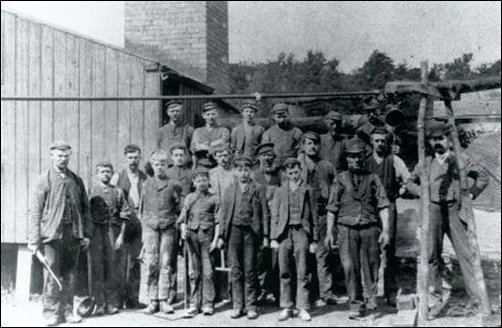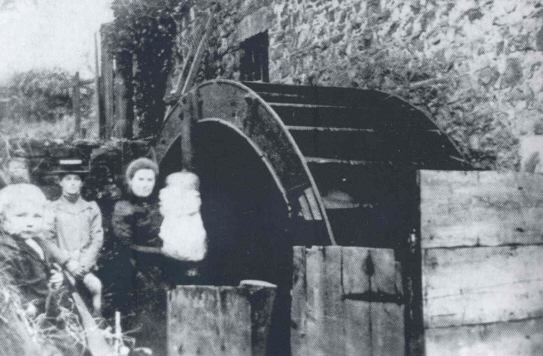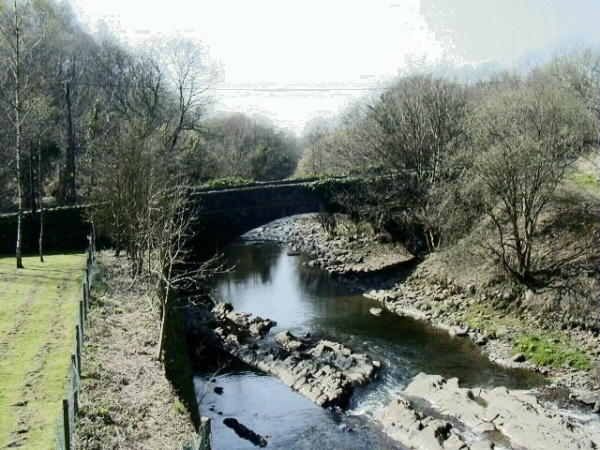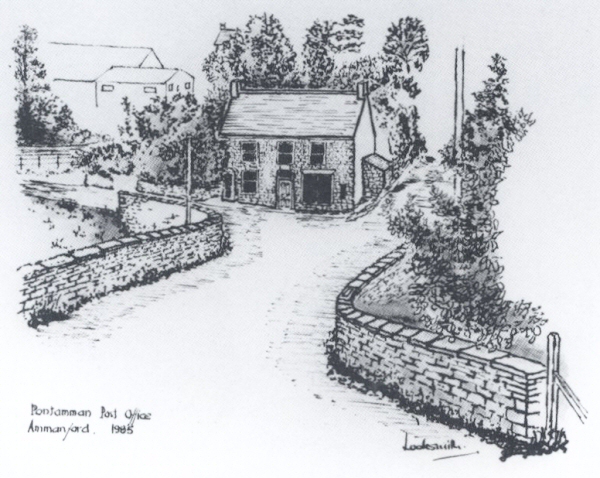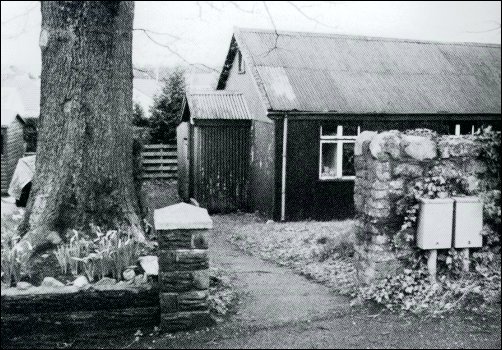PONTAMMAN CHEMICAL WORKS
(AMMAN BRIDGE CHEMICAL WORKS)
and the Pontamman area
1 Introduction 2 Pontamman Chemical Works 3 Pontamman Chemical Works School, Cross Inn 4 Pontamman House 5 Pontamman Mill 6 Pontamman Bridge 7 The Public Houses 8 The Churches 1. Introduction
How soon a familiar place can change and become unrecognizable to us; and how soon it's forgotten completely once no-one is left with personal memories of it. Pontamman today is just another part of the Ammanford conurbation with little or no character of its own any more. Yet it wasn't that long ago that Pontamman was the centre of coal mining for the town, with three collieries (Ammanford Number 1 and 2 mines, and the Dynevor and Maesquarre colliery), a colliery washery, a coal tip that became wooded over in time, a brickworks and a flour mill. There were two pubs (the Bridgend and Mount Pleasant); a post office (which closed in 1971); three little churches (the Anglican St Thomas, Siloam Methodist Sunday school, and the Christadelphians) and a charming stone bridge built a hundred and sixty years ago. There is also a railway bridge over which a steam locomotive conveying passengers along the Amman valley branch line once chuffed and puffed its picturesque little way to Gwaun Cae Gurwen and Brynamman. All these are within living memory, and the stone bridge still stands, though closed off to traffic, and the railway bridge still crosses the river Amman at this point, but minus the trains it was originally designed to carry. But there were also once a flour mill powered by a water wheel and a chemical works, both of which disappeared too long ago for anyone now alive to claim a personal acquaintance with them. There were three mansions (Wernoleu, Pontamman House and Maesquarre) where local gentry families lived in a style incomprehensible to the coal miners, agricultural labourers and factory workers who lived just a stone's throw away. Pontamman House lost its grandeur when it was converted into three smaller residences after the Second World War; Wernoleu became the grand abode for the local coal-owner before becoming a residential hotel, leaving Maesquarre House as the only one now still in use as a private residence.
1 Introduction 2 Pontamman Chemical Works 3 Pontamman Chemical Works School, Cross Inn 4 Pontamman House 5 Pontamman Mill 6 Pontamman Bridge 7 The Public Houses 8 The Churches 2. The Chemical Works
In 1827 or thereabouts Messrs. Samuel Chivers & Bowen Ltd. founded the Amman Bridge Chemical Works. As this part of Ammanford became known as Pontamman the place later became more familiarly known as the Pontamman Chemical Works. Around 1835 William Morris of Plas-y-Felin (previously known as Ty'n-y-coed House and now as Pontamman House), became involved in the enterprise.
The Amman Bridge Chemical Works is believed to have been the first major industrial venture (other than coal mining) in the area. It contained two factories, one processing timber (felled from forests in the locality) into charcoal, along with white and brown vitriol/vinegar, and the other producing paint. Initially there were three ovens and four machine shops, increased later to twenty-one ovens and twenty-four machine shops. The workforce in 1871 was recorded as 62 males, 13 women and 26 boys, working a twelve hour shift at a wage of eighteen shillings for a six day week.
A group of chemical workers at Pontamman circa 1900. With no extraction or ventilation equipment the grinding machines preparing the paint pigments were hazardous, to say the least: workmen at the end of the shift were literally covered in powder dust and it wasn't unusual to see red- or green-faced men in the hamlet. Depending on their colouring, management were able to judge how hard they had performed on the shift. The smart lads, however, avoided strenuous efforts by adorning their faces with colour dye in an attempt to confuse their masters. Irrespective of these little tricks, working conditions were deplorable and washing bowls or any other washing facilities were unknown.
In other matters concerning welfare of workers they were a little more far-sighted (mainly due to the influence of Anne Morris, the wife of William Morris, the proprietor), and around 1840 a school was set up for children of the employees, what today would be described as a creche. The school was located in a separate building on the opposite side of the road – official reports record it as the Pontamman Chemical Works School. In 1877 there were 38 pupils on the register; in 1880, 34; and in 1882, 50 children.
These premises were also utilised for religious purposes, being entered in the Religious Census in 1851 as a Wesleyan Methodist Chapel, having seating capacity for 72, with attendance at morning and evening services being then registered as 35. Mr William Morris was named as steward.
Some records of this school have come down to us and offer a glimpse into a school system barely recognizable to us now after a century of state-funded education. Until a Parliamentary Act in 1902 transferred responsibility for elementary education to local County Councils just about anyone could open and run a school. In practice schools were run either by private individuals or voluntary bodies and the two main voluntary bodies of the nineteenth century were governed by religious interests.
On the technical side, management at Pontamman Chemical Works were advanced for their day, installing a generator for production of electricity, the first plant to operate in the district. Sons Edward Sumner Morris and Herbert L. Morris followed into the business. Financial difficulties appeared in 1887 which split the identity of the company, forming a partnership with the Callard brothers (who until this period had been employees at the works).
The two factories, as comparatively small units, faced fierce competition and were economically vulnerable – it is said that a very severe winter in the early 1900s, when the River Amman (their source of water supply) iced up, caused a complete disruption of production, leading to the eventual closure of the Works.
Very little use was made of the premises in the years following; being more-or-less abandoned the buildings slowly fell into a state of disrepair, to become the home of a gypsy family and later a sort of builder's yard.
The crunch came in 1965, when Mr. R.W. Marsh of the Economic Garage, High Street, organised the entry of bulldozers to clear the site for his new motor garage, showrooms and petrol filling station (now Tout's Pontamman Garage).
1 Introduction 2 Pontamman Chemical Works 3 Pontamman Chemical Works School, Cross Inn 4 Pontamman House 5 Pontamman Mill 6 Pontamman Bridge 7 The Public Houses 8 The Churches 3. Pontamman Chemical Works School, Cross Inn
One of the few schools known in Ammanford at this time was a private concern run by the proprietor of the Amman Chemical Works which seems to have survived for about ten years after the opening of Ammanford County Primary School in 1870. This school was established in the 1840s by a Mr. Morris, the proprietor of Pontamman Chemical Works, and the Brodies, who later took over the concern, carried on the school. The pupils at the school seem to have been children of the employees, a sort of creche as well as school, so it would have been quite progressive for the time. The owners of the chemical works also ran a Wesleyan Methodist church in this school building so maybe their motive was control rather than education, with the company regulating just about every aspect of their employees' lives.
William Roberts was a Baptist minister who worked for one of the religious bodies overseeing education, the British Society, which ran schools attended by children from non-conformist families. (The other religious body was the National Society, educating the offspring of church worshippers). William Roberts travelled extensively throughout South Wales to ensure children's education didn't fall into the wrong, ie Church, hands. The draft of the journal of his activities from 1853 to 1862, written for the information of the Society's Committee, is preserved in the National Library of Wales and is a valuable document for the history of elementary education in South Wales. Roberts' diary records several visits to the Amman Valley, including Cross Inn, renamed Ammanford in 1880. William Roberts wrote most contemptuously in his diary about the school at Pontamman:
September 26 1856
Pontamman: There is a small mixed school in this place established by Mr. Morris, proprietor of the chemical works. There are 40 children, but the young woman that is the schoolmistress is not at all adapted to the work. She is the daughter (21 years of age) of the schoolmistress at Cross Inn (Miss Edwards). She only gets off Mr. Morris £10 per annum. It is only the name of a school, and I thought of seeing Mr. Morris, but he was away from home. I will visit again, and urge him to establish a good school.In spite of the agent's gloomy report, the Pontamman school persisted at least until 1882, and also qualified to receive grants from the Committee of Council. The school was open to all children, and those parents who could afford nothing sent their children free of charge.
Attendance Figures
1877-78 Average attendance 38. Annual Grant £25-18-0.
1880 Accommodation for 57. Average attendance 34. Annual Grant £24-8-0.
1882 Accommodation for 57. Average attendance 50. Annual Grant £34-10-0.(The above is from http://www.genuki.org.uk/big/wal/Roberts4.html)
1 Introduction 2 Pontamman Chemical Works 3 Pontamman Chemical Works School, Cross Inn 4 Pontamman House 5 Pontamman Mill 6 Pontamman Bridge 7 The Public Houses 8 The Churches 4. Pontamman House
Pontamman House was one of the gentry manor houses of the area, dating back to the early 1800s, and known also by other names – Maes-y-Felin (Mill Field) or Plas-y-Felin (Mill Mansion). It was the residence of William Morris, who not only became involved in the Amman Bridge Chemical Works, but was known as the peacemaker of the valley, an industrial arbitrator respected by all parties, gaining recognition for his diplomacy in settling arguments and disputes that arose from time to time in the town's workplaces
In the 1890s, Pontamman House became the residence of Samuel Callard, who by this time was a partner in the Pontamman Chemical Works. A native of Torquay, he came with his family to Ammanford in 1875 and along with his father – Thomas Callard – took a prominent role as founders of the English Wesleyan Church in Wind Street, Ammanford, in 1875. It is said that he inaugurated the first Sunday school Whitsun event in Ammanford, assembling the Sunday schools at Pontamman House for a march down Pontamman Road to High Street and into the town's centre. He died on the 21st of December 1906, at the age of 60.
In the years after the Second World War the property was converted into three private residences, including the Old Coach House.
1 Introduction 2 Pontamman Chemical Works 3 Pontamman Chemical Works School, Cross Inn 4 Pontamman House 5 Pontamman Mill 6 Pontamman Bridge 7 The Public Houses 8 The Churches 5. Pontamman Mill
The water corn gristmill, or flour mill as it is better known, was originally called Ty'n y Coed Mill. The exact age of the mill has not been uncovered but the parish records disclose that it was in existence in 1829. It is thought to be much older. In 1840 the mill was part of a small industrial complex. An agreement dated 1840 concerning the Chemical Works on the complex also mentions the mill. There appears to have been a grievance of some kind between Jonathan Chivers of Ty'n y Coed house, John Calder of Victoria Street, London, and William Bowen of Ty'n y Coed Mill.
Ty'n y Coed Mill was a long two-storey building with one half used as the domestic quarters of the miller and his family. In 1875 the registered miller was David Harries. It appears to have had two millponds, allowing one to be used while the other refilled. This provided a continuous supply of water to the mill wheel, which is thought to have been an undershot wheel, allowing the water to cascade down onto the wheel and then pass away underneath.
The course of the leat which fed the millpond and the dam on the River Amman can still be traced. The mill has been ruined over the years and is now hidden between a cluster of trees and overgrowth. There are a few walls remaining, along with the millstones, and some of the machinery is still in place. With a little initiative it would not be impossible to reconstruct this mill. Pontamman Mill remained in operation up to the first half of the 20th century, when for some reason there was a lack of water. This lack of water prompted the owners to make an attempt to obtain an electricity supply. A supply failed to materialise and the mill ceased to function.
The photograph below was taken between 1908 and 1909 shows a Mrs Elizabeth Walters standing outside the mill holding a baby in her arms. The baby's name was Claudia.
The mill lay unused for decades, slowly deteriorating. The Welsh heritage organisation Cadw (Cadw is the Welsh for 'to keep') surveyed the buiilding in 1994; here is their report:
Location: Situated amid trees below main A474 road some 150m W of Pontamman House.
History: Mostly C19 with earlier origins.
Exterior: Flour mill in squared rubble stone with some brick dressings and blockings, and slate roofs, largely collapsed (1993), stone SW end stack. Two apparent storeys externally, full-height opening to central hoist area, various window openings with simple wood frames or blocked under plain timber or stone voussoir lintels. Wheelpit at NE without wheel. Drive shaft opening in wall. Collapsed rear lean-tos.
Interior: Derelict 1988 (more so 1993) but retaining most of the drive machinery including shafts and gearing together with millstones. D-frame truss supports main vertical timber drive shaft. Former miller's house within SW end.
Listed: Of special interest despite advanced state of dereliction (Spring 1993) for the scarce surviving machinery.
Reference: Marked on 1876 Ordnance Survey: Carmarthenshire Sheet 48 NE.
Despite being of "special interest ... for the scarce surviving machinery" the end came in May 2010 when the owners suddenly, and without any warning, completely cleared the site, to considerable local protest, as the local newspaper reported:
.....THERE is outrage over the demolition of one of the Amman Valley's most historic buildings.
.....The Old Pontaman Water Mill, believed to date back more than 200 years, has been razed to the ground.
.....Community leader Kevin Madge felt the historic building should have been preserved.
.....“What's happened is outrageous – the old mill is something that has been there for generations,” he said.
.....“We don't have many historic buildings in the valley, so we should protect the ones we have left because they are part of our heritage.”
.....Guardian reader John Lewis also expressed dismay.
.....“Ammanford doesn't have a very good track record for looking after its historic buildings, does it?” he said Local historian Terry Norman, who has also argued for the mill's restoration, said parish records showed the building was in existence in 1829, although it was thought to be much older.
.....A Carmarthenshire Council spokesman confirmed the mill had been demolished and the surrounding land cleared.
.....“There is no pending application/permission for any development,” he said. “The matter has been passed on to our enforcement section, who are now considering the options available to address the situation; including instigating prosecution proceedings against the owner.”(South Wales Guardian, 5th May 2010)
1 Introduction 2 Pontamman Chemical Works 3 Pontamman Chemical Works School, Cross Inn 4 Pontamman House 5 Pontamman Mill 6 Pontamman Bridge 7 The Public Houses 8 The Churches It was not until the early 1700s that a bridge, a composite timber framed structure, was built to cross the river Amman at what is today known as Pontamman. Survey maps of Carregamman Uchaf farm (on what is now High Street) were prepared in 1779 by Mathew Williams for the owner of the land, the Rt. Honourable George Rice MP (George Rice was the ancestor of today's 10th Lord Dynevor, the peerage being created in 1780). These maps show a bridge and roadway connecting the top end of High Street to Nant Melyn Square (Millbrook Square), which would in time be renamed Pontamman bridge.
Next, improvements in communications in the 1800s led to the construction of a toll road from Pontamman to Glynmoch and the old wooden bridge was replaced by a stone bridge shortly after the formation of the Brynamman railway line in 1842, which also needed a railway bridge at this point. The stone bridge, although an elegant structure, was built at right angles to the river. The resulting 'S' bend formed dangerous approaches in either direction, even for the original horse and cart traffic. The increasing motor traffic of the twentieth century, compounded by the fact that there was no pedestrian pavement on the bridge, resulting in numerous deaths over the years and in 1969 a new bridge, built at a straighter angle across the river, replaced the old stone structure. The original stone bridge is still there and is still used by walkers taking a shorter route from Maesquarre Road to High Street.
Pontamman stone bridge over the river Amman, built in 1842. The railway bridge, built at the same time, still runs alongside as a coal line from the open cast site in Tairgwaith. Replaced in 1969 with a brand new metal-girdered bridge at a safer angle to the river, the old bridge still stands alongside the new one.
1 Introduction 2 Pontamman Chemical Works 3 Pontamman Chemical Works School, Cross Inn 4 Pontamman House 5 Pontamman Mill 6 Pontamman Bridge 7 The Public Houses 8 The Churches 7. The Public Houses
Pontamman post office at the Betws end of Pontamman bridge (built in 1840). The post office was closed in 1971 (drawing WTH Locksmith, 2000). No community seems complete without a church, a public house and a post office in its vision of perfection (and if you want to romanticise the memory even further you could add a village green). Well, most of the country's post offices have closed in recent years, and the rest will surely follow if current government policies continue. We still have our Church buildings but not their congregations any more, which have dwindled to almost nothing. Cheap supermarket booze has killed off many of our pubs or reduced plenty of the rural ones to weekend opening only. Pontamman can be seen as a classic example of this trend: its post office closed in 1971; one of its churches, the Methodist Siloam Sunday school, closed in 1999; and one of the area's two pubs is now a restaurant. For the sake of completeness here are brief histories of Pontamman's two public houses and three churches.
The Bridgend Hotel
Dating back before 1875 there was an ale house located near the bridge, appropriately named the Bridgend Hotel. The workers from the old Chemical Works repaired to this establishment to quench their thirst after a hard day. In 1890 Ammanford number 1 colliery opened a couple of hundred yards from the alehouse, and in 1891 Ammanford number 2 colliery sprouted up literally next door, and the chemical workers were now joined by an equally thirsty workforce. The 1881 census shows that the inn Keeper was a Mr John Jones who by the 1891 census had acquired a wife, Mrs Lucy Jones. In common with most public houses in the district it would become one of Buckleys establishments of tied houses. Buckleys was a Llanelli brewery enjoying almost a complete monopoly of pubs in the area. But in 1996, as part of the Brewery's policy to divest itself of many of its smaller outlets, Buckleys sold the Bridgend Hotel to a local businessman, the establishment then reverting to a free house. Then after extensive renovations it was re-opened in 1999 as a hotel and restaurant, under the new name of Yr Hên Bont, (the Old Bridge). Time does not stand still even in sleepy Pontamman, and in 2003 it became a Chinese restaurant, the same year coincidentally that nearby Betws Colliery, the last deep mine in the Amman valley, closed. Out with the old and in with the new.The Mount Pleasant Hotel
The other ale house in Pontamman, the Mount Pleasant Hotel, was built prior to 1861 when the inn keeper was recorded as being Mr John James; in 1871, Mr Hopkin Isaac, and in 1891, Mr David Roberts were mine hosts. In the mid 1930s, it was taken over by a Neath brewery, selling Roberts Beers, a rare product in what was traditionally Buckleys country. Under a rationalisation of the brewery, the ownership passed over to Messrs. Wm Hancocks & Co Ltd. in 1962, to be later sold and opened up as a free house in 1971, this time acquiring the new name of the Perrivale, after the pub's new owner, one Joe Perry. For some reason best known to the perpetrator, the pub later changed its name to Bumbles, though fortunately the name has since reverted to the Perrivale.
1 Introduction 2 Pontamman Chemical Works 3 Pontamman Chemical Works School, Cross Inn 4 Pontamman House 5 Pontamman Mill 6 Pontamman Bridge 7 The Public Houses 8 The Churches 8. The Churches
(a) Ysgol Sul Siloam (Siloam Sunday School)
Due to the large geographical area from which the congregation were drawn, the elders of the Welsh Methodist Capel Newydd in Betws were aware of the difficulties for young children walking long distances to attend the Sunday school at the chapel in Betws Road, an especially arduous journey during the winter months. To overcome these problems they organised meeting places at various homes of their members throughout the district.These arrangements were not altogether satisfactory; when a large number of children and adults invade one's home, disruption is sure to occur and there was also the problem of co-ordinating such functions. It is recorded that Mr David Jones of ‘Plas-y-nant', Maesquarre Road, would be seen on Sundays with a sack slung over his shoulder, carrying a collection of bibles and other religious reading matter to these venues.
Thoughts therefore turned to the provision of proper facilities, leading to the establishment of Sunday schools at Penllech (covering the southern area to the River Cathan), and Siloam, located in Maesquarre Road to the north.
On the 17th of April 1904, a leasehold agreement was signed with Mr. John Lewis Williams of Maesquarre Hall for a plot of land some twenty and a half perches in Coronation Terrace, upon payment of eight shillings per annum as ground rent. The Sunday school erected on this spot in 1905 was to be called Siloam. The name is biblical in origin: Siloam was a pool near Jerusalem where Christ cured a man of blindness by commanding him to wash in the pool (John 9,7). The class composition of the elders and members associated with this project reflected the working class nature of non-conformism at the time. They were: Thomas Davies ‘Llwynyfedwen', Bettws, (engineman); Thomas Thomas, ‘Pantybanwen', Bettws, (farm labourer); Richard Higgs, ‘Tanyrallt', Bettws, (coal miner); Evan James, ‘Castell Evan', Bettws, (chemical worker); Jonah Rees, ‘Brynheulog', Bettws, (grocer): William Rees, College Street, Ammanford (carpenter); William Davies, Pantyfallen', Bettws (coal miner); John Davies, ‘Wernherod', Bettws, (coal miner); David Davies, ‘Llwynyfedwen', Bettws, (coal miner); Henry Morris, ‘Pantyfallen', Bettws (coal miner); Henry Morris, ‘Pantyfallen', Betws, (coal miner) along with Rhys Thomas, (schoolmaster).
With the disposal of the Maesquarre estate in the 1920s it appears that William Herbert of ‘Llwynon', High Street, purchased various plots of land, including the freehold of Siloam which upon his death were inherited by his children.
Besides being a Sunday school of Capel Newydd over the years the building became a focal point for various functions and a meeting hall for local inhabitants. As with so many other institutions failing attendances and support made it difficult for the chapel to sustain the Sunday school and eventually the elders had no alternative but to close the premises. Being unoccupied the structure soon fell into a state of disrepair and demolition commenced in June 1999. A landmark which had stood for nearly one hundred years was to disappear overnight.
(b) St Thomas Church, Wernoleu
St Thomas, a modest mission church, was built on land which one time formed part of the country estate of Wernoleu in Pontamman, to serve the Anglican population of High Street, Pontamman, Hopkinstown and Maesquarre Road. Wernoleu house and its lands were owned and occupied between 1885 and 1903 by one Reverend Thomas Davidson BA. He died in 1897 and a plaque on the wall of St Davids church, Betws, commemorates his tenure in the parish. He had been the Rector of Ashmore in Devon prior to taking residency in Ammanford and it's believed he and his family were very much involved in the establishment of St Thomas church sometime around 1890.The first building was originally conceived as a temporary structure and constructed accordingly with timber framework and corrugated iron cladding. Palatial is a description no-one has ever applied to the church and as late as the 1980s the heating system consisted of a free-standing, cast-iron, cylindrical stove with a flue pipe extending up to the roof. The church had been built in the reign of Queen Victoria and remained very much of that era for another hundred years. On occasions, inclement weather conditions caused a downdraft in the flue and the resulting smoke-filled room made it difficult for the congregation to see their minister or the minister to see his flock. Still, a dedicated community spirit has kept the church and its Sunday school open for over a century
The original corrugated-iron-clad mission church of St Thomas After the departure of the Davidson family, Wernoleu and its grounds were bought by the Ammanford Colliery Company as the residence for its managing director, Mr Ernie Hewlett. The former gentleman's residence was later used for the same purpose by the Amalgamated Anthracite Collieries Limited when they bought up the Ammanford Colliery Company in 1923. On nationalisation of the mining industry in 1947 the nation, in the form of the National Coal Board, acquired the premises and Wernoleu became the residence of the manager of NCB Area Number 9. In 1965 the NCB finally sold Wernoleu house on the open market and it became a country club and hotel, eventually renamed from Wernoleu to Ammanford Hotel in 2003.
During all these changes St Thomas continued unchanged in its original role as a place of Anglican worship. Ernie Hewlett took a strong interest in the little church, as did many other pillars of the local community.
The temporary building, however, proved to be more permanent than anticipated, with the result that the structure deteriorated badly over the century of its life, its countless temporary repairs struggling to hold back the ravages of time. It was when a section of the wooden floor collapsed during a church service that a decision was taken to rebuild rather than repair. A committee – the Friends of St Thomas – was formed and within a year had raised sufficient funds to build a completely new building, a large part of the construction work being carried out voluntarily by church members.
On the 3rd December 1995 the first service was held in the new building, a tribute to community spirit at a time when most other places of worship in the area are experiencing a collapse in membership, and with some churches and chapels even disappearing altogether before the bulldozer's advance.
(c) The Christadelphians
Little is know of the history of this small Christian sect in Ammanford but they have been in the area since at least 1892 when they had a church in the Tirydail area of Ammanford (Tirydail is usually translated as 'land of the leaves'). In 1906 their church was used for a while by the area's Welsh-speaking Wesleyan Methodists until they built their own church in Tirydail in 1911. Upon the departure of the Wesleyans the Anglican church purchased the building and it was used as a mission church for Tirydail Anglicans until its abandonment in 1974. The Christadelphian church is currently situated in Pontamman, though it is imminently due for demolition to make way for the new Ammanford bypass. When the bulldozers have completed their destruction the Christadelphians plan to re-erect their little church in Foundry Road, Ammanford.Sources:
– WTH Locksmith: Ammanford: Origins of street names and other notable historical records, pages 195-203. Carmarthen, 2000.
– Betws History Group: Betws Mas o'r Byd, 2001
– William Roberts: Journals, 1853-1862.
1 Introduction 2 Pontamman Chemical Works 3 Pontamman Chemical Works School, Cross Inn 4 Pontamman House 5 Pontamman Mill 6 Pontamman Bridge 7 The Public Houses 8 The Churches

